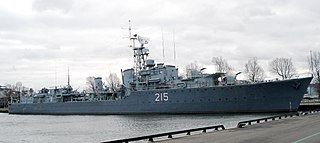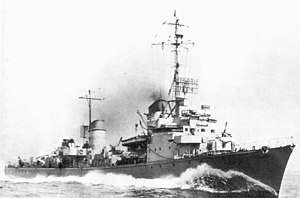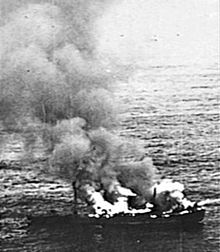
HMCS Haida is a Tribal-class destroyer that served in the Royal Canadian Navy (RCN) from 1943 to 1963, participating in World War II and the Korean War. She was named after the Haida people.

HMCS Athabaskan was the first of three destroyers of the Royal Canadian Navy to bear this name. It was a destroyer of the Tribal class, that served in the Second World War. She was named for the First Nations peoples who make up the Athabaskan language group. She was torpedoed in the English Channel and sunk in 1944.

The Battle of Ushant, also known as the Battle of Brittany, occurred on the early morning of 9 June 1944 and was an engagement between German and Allied destroyer flotillas off the coast of Brittany. The action came shortly after the initial Allied landings in Normandy. After a confused engagement during the night the Allies sank one of the German destroyers and forced another ashore, where she was wrecked.

Z24 was one of fifteen Type 1936A destroyers built for the Kriegsmarine during World War II. Completed in 1940, the ship spent the first half of the war in Norwegian waters. She was very active in attacking the Arctic convoys ferrying war materials to the Soviet Union in 1941–1942, but only helped to sink one Allied ship herself.

The German torpedo boat T25 was one of fifteen Type 39 torpedo boats built for the Kriegsmarine during World War II. Completed in late 1942, she was transferred to France in July 1943. T25 was unsuccessfully attacked by Allied motor torpedo boats and aircraft during her voyage down the English Channel and then came to the aid of a convoy being attacked by Allied destroyers. Later that year she escorted blockade runners and Axis submarines through the Bay of Biscay. T25 also helped to lay minefields in the English Channel in mid-1943. She participated in the Battle of Sept-Îles in October and was sunk two months later by British light cruisers during the Battle of the Bay of Biscay.

The German torpedo boat T26 was one of fifteen Type 39 torpedo boats built for the Kriegsmarine during World War II. Completed in early 1943, the boat was transferred to France in August. T26 helped to lay a minefield in the English Channel the following month, and later escorted a blockade runner through the Bay of Biscay. She participated in the Battle of Sept-Îles in October and was sunk two months later by a British light cruiser during the Battle of the Bay of Biscay.

ZH1 was the lead ship of her class of four destroyers built for the Royal Netherlands Navy in the late 1930s. Originally named Gerard Callenburgh, the ship was scuttled while still incomplete by the Dutch during the German invasion of the Netherlands in May 1940, but she was salvaged by the Germans a few months later and commissioned in the Kriegsmarine in 1942 as ZH1.

The Battle of the Bay of Biscay, or Operation Bernau, was a naval action that took place on 28 December 1943 during World War II as part of the Atlantic campaign. The battle took place in the Bay of Biscay between two light cruisers of the British Royal Navy, and a destroyer and a torpedo boat flotilla of the German Kriegsmarine hoping to intercept and escort a blockade runner. The battle was fought as part of the Allied Operation Stonewall, which was to intercept German blockade runners off the west coast of France. In the confused action that followed the two British cruisers HMS Enterprise and HMS Glasgow respectively sank T26, together with her sister ship T25 and the destroyer Z27.

Z32 was a German Type 1936A (Mob) destroyer, which was completed in 1942 and which served with the 8th Destroyer Flotilla of the Kriegsmarine during the Second World War. She fought in the Battle of the Bay of Biscay against HMS Glasgow and HMS Enterprise, alongside the German 8th Destroyer Flotilla and the 4th Torpedo Boat Flotilla. She mainly operated from German-occupied French Atlantic ports, escorting blockade runners and U-boats, and was sunk during the Battle of Ushant on 9 June 1944.

Z37 was a Type 1936A (Mob) destroyer built for the Kriegsmarine during World War II. Completed in 1942, the ship spent most of her brief career deployed in France. She participated in the Battle of the Bay of Biscay at the end of 1943 before she was accidentally rammed by the destroyer Z32 in early 1944. Towed back to port, the Kriegsmarine decided that Z37 was too badly damaged to repair and disarmed her hulk. Decommissioned later that year, she was scuttled by her crew before being scrapped by the French in 1949.

Greif was the third of six Type 23 torpedo boats built for the German Navy. The boat made multiple non-intervention patrols during the Spanish Civil War in the late 1930s. During World War II, she played a minor role in the Norwegian Campaign of 1940 by transporting troops that captured Arendal. Greif spent the next couple of years escorting minelayers as they laid minefields and laying minefields herself. She also spent the latter half of 1941 escorting convoys through the Skagerrak. The boat had a lengthy refit that lasted all of 1942 and then spent March–April 1943 escorting ships in Norwegian waters before returning to France. While deployed there Greif laid numerous minefields and escorted U-boats through the Bay of Biscay. The boat was sunk by Allied aircraft in May 1944.

Kondor was the fifth of six Type 23 torpedo boats built for the German Navy. The boat made multiple non-intervention patrols during the Spanish Civil War in the late 1930s. During World War II, she played a minor role in the attack on Oslo, the capital of Norway, during the Norwegian Campaign of 1940. Kondor spent the next several months escorting minelayers as they laid minefields and damaged heavy ships back to Germany before she was transferred to France around September. She started laying minefields herself that month and continued to do so for the rest of the war. The boat returned to France in 1942 and helped to escort blockade runners, commerce raiders and submarines through the English Channel and the Bay of Biscay. Damaged by a mine shortly before the Allied Invasion of Normandy in June 1944, Kondor was under repair on the day of the landings. Recognizing that she could not be repaired quickly, the boat was decommissioned later that month and was then further damaged by British bombers so that she was declared a constructive total loss.

Möwe was the lead ship of her class of six torpedo boats built for the German Navy. The boat made multiple non-intervention patrols during the Spanish Civil War in the late 1930s. During the Norwegian Campaign of 1940, she played a minor role in the attack on Oslo, the capital of Norway. Möwe was torpedoed and badly damaged by a British submarine in May and did not return to active service until 1942 when she was transferred to France. The boat helped to escort blockade runners, commerce raiders and submarines through the Bay of Biscay. She also laid numerous minefields and attacked Allied ships during the Invasion of Normandy in June 1944. Möwe was sunk by British bombers that same month.

Jaguar was the sixth and last Type 24 torpedo boat built for the German Navy during the 1920s. The boat made multiple non-intervention patrols during the Spanish Civil War in the late 1930s. During World War II, she played a minor role in the Norwegian Campaign of 1940. Jaguar spent the next several months escorting minelayers as they laid minefields and damaged heavy ships back to Germany before she was transferred to France around September. She started laying minefields herself that month and continued to do so for the rest of the war. After a refit in early 1941, the boat was transferred to the Skaggerak where she was assigned escort duties. Jaguar returned to France in 1942 and was one of the escorts for the capital ships sailing from France to Germany through the English Channel in the Channel Dash. She helped to escort blockade runners, commerce raiders and submarines through the Channel and the Bay of Biscay, as well as Norwegian waters, for the next several years. The boat attacked Allied ships during the Invasion of Normandy in June 1944, but was sunk by British bombers that same month.

The Type 1939 torpedo boats, also known as the Elbing class by the Allies, were a group of 15 torpedo boats that were built for Nazi Germany's Kriegsmarine during World War II.

The German torpedo boat T29 was one of fifteen Type 39 torpedo boats built for the Kriegsmarine during World War II. Completed in mid-1943, the boat was transferred to France in January 1944. She fought in the Action of 26 April off the coast of Brittany, and was sunk by four Allied destroyers with the loss of 137 crewmen.

The German torpedo boat T28 was one of fifteen Type 39 torpedo boats built for the Kriegsmarine during World War II. Completed in mid-1943, the ship was transferred to France in January 1944 and slightly damaged by British aircraft en route. She attacked Allied ships during the Invasion of Normandy in June 1944 and returned to Germany the following month. T28 was assigned to support German operations in the Baltic Sea. She escorted convoys and larger warships bombarding Soviet troops as well as bombarding them herself. In May T28 helped to evacuate troops and refugees from advancing Soviet forces. The ship was allocated to Great Britain after the war, but she was transferred to France in 1946. The French Navy renamed her Le Lorrain and recommissioned her in 1949. After serving with different units of the Mediterranean Squadron, she was condemned in 1955 and subsequently sold for scrap.

The German torpedo boat T27 was one of fifteen Type 39 torpedo boats built for the Kriegsmarine during World War II. Completed in early 1943, the boat was transferred to France in August. T27 helped to lay a minefield in the English Channel the following month, and later escorted a blockade runner through the Bay of Biscay. She participated in the Battle of Sept-Îles in October and played a minor role in the Battle of the Bay of Biscay. The boat was lightly damaged during the action of 26 April 1944 off the coast of Brittany and ran aground during the subsequent battle two days later. Her wreck was destroyed shortly afterwards by the British.

The German torpedo boat T22 was one of fifteen Type 39 torpedo boats built for the Kriegsmarine during World War II. Completed in early 1942, the ship was transferred to France later that year where she escorted blockade runners and Axis submarines through the Bay of Biscay. T22 also laid minefields in the English Channel in mid-1943. She participated in the Battle of Sept-Îles, where she crippled a British destroyer, and the Battle of the Bay of Biscay later that year. After returning to Germany in early 1944, T22 struck a pair of mines in Narva Bay in August and blew up, with the loss of 143 men.

The German torpedo boat T23 was one of fifteen Type 39 torpedo boats built for the Kriegsmarine during World War II. Completed in mid-1942, the boat was stationed in France later that year where she escorted blockade runners and U-boats through the Bay of Biscay. T23 also laid minefields in the English Channel in mid-1943. She participated in the Battle of Sept-Îles and the Battle of the Bay of Biscay later that year, neither receiving nor inflicting any damage.














